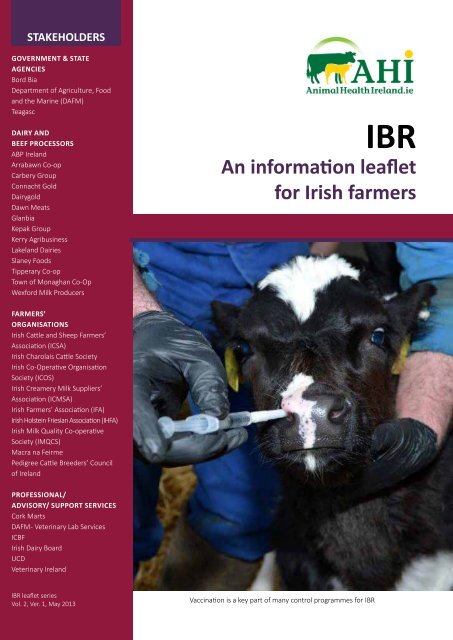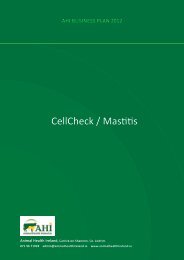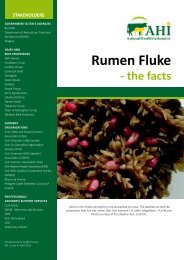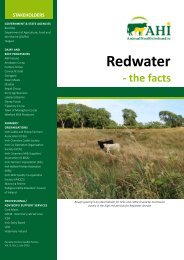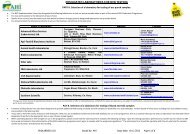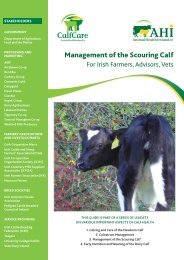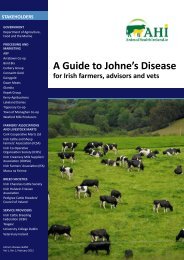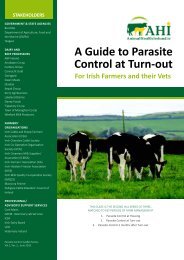IBR - an information leaflet for Irish Farmers - Animal Health Ireland
IBR - an information leaflet for Irish Farmers - Animal Health Ireland
IBR - an information leaflet for Irish Farmers - Animal Health Ireland
You also want an ePaper? Increase the reach of your titles
YUMPU automatically turns print PDFs into web optimized ePapers that Google loves.
STAKEHOLDERS<br />
Government & State<br />
Agencies<br />
Bord Bia<br />
Department of Agriculture, Food<br />
<strong>an</strong>d the Marine (DAFM)<br />
Teagasc<br />
Dairy <strong>an</strong>d<br />
Beef Processors<br />
ABP Irel<strong>an</strong>d<br />
Arrabawn Co-op<br />
Carbery Group<br />
Connacht Gold<br />
Dairygold<br />
Dawn Meats<br />
Gl<strong>an</strong>bia<br />
Kepak Group<br />
Kerry Agribusiness<br />
Lakel<strong>an</strong>d Dairies<br />
Sl<strong>an</strong>ey Foods<br />
Tipperary Co-op<br />
Town of Monagh<strong>an</strong> Co-Op<br />
Wex<strong>for</strong>d Milk Producers<br />
<strong>IBR</strong><br />
An <strong>in<strong>for</strong>mation</strong> <strong>leaflet</strong><br />
<strong>for</strong> <strong>Irish</strong> farmers<br />
<strong>Farmers</strong>’<br />
Org<strong>an</strong>isations<br />
<strong>Irish</strong> Cattle <strong>an</strong>d Sheep <strong>Farmers</strong>’<br />
Association (ICSA)<br />
<strong>Irish</strong> Charolais Cattle Society<br />
<strong>Irish</strong> Co-Operative Org<strong>an</strong>isation<br />
Society (ICOS)<br />
<strong>Irish</strong> Creamery Milk Suppliers’<br />
Association (ICMSA)<br />
<strong>Irish</strong> <strong>Farmers</strong>’ Association (IFA)<br />
<strong>Irish</strong> Holstein Friesi<strong>an</strong> Association (IHFA)<br />
<strong>Irish</strong> Milk Quality Co-operative<br />
Society (IMQCS)<br />
Macra na Feirme<br />
Pedigree Cattle Breeders’ Council<br />
of Irel<strong>an</strong>d<br />
Professional/<br />
Advisory/ Support Services<br />
Cork Marts<br />
DAFM - Veterinary Lab Services<br />
ICBF<br />
<strong>Irish</strong> Dairy Board<br />
UCD<br />
Veterinary Irel<strong>an</strong>d<br />
<strong>IBR</strong> <strong>leaflet</strong> series<br />
Vol. 2, Ver. 1, May 2013<br />
Vaccination is a key part of m<strong>an</strong>y control programmes <strong>for</strong> <strong>IBR</strong>
Page 2<br />
Please refer to the disclaimer on the last page regarding <strong>in<strong>for</strong>mation</strong> in this <strong>leaflet</strong>.<br />
<strong>IBR</strong> (infectious bovine rhinotracheitis)<br />
• is caused by a herpesvirus (Bovine Herpes Virus-1 (BoHV-1)) also known as <strong>IBR</strong>V (<strong>IBR</strong> virus)<br />
• virus is spread mainly by close contact between <strong>an</strong>imals<br />
• airborne spread of virus may occur over dist<strong>an</strong>ces of up to 5m<br />
• may also be spread by semen from infected bulls, using contaminated equipment <strong>an</strong>d by people who have<br />
recently h<strong>an</strong>dled infected <strong>an</strong>imals.<br />
In this document we will refer to <strong>an</strong>y infection with Bovine Herpes Virus-1 as <strong>IBR</strong>, even though some infections are<br />
not associated with obvious respiratory disease.<br />
Infections with <strong>IBR</strong> result in losses in production, <strong>an</strong>imal welfare issues, potential trade barriers <strong>an</strong>d reduction of the<br />
genetic pool available to AI stations.<br />
Clinical signs associated with (but not unique to) <strong>IBR</strong>:<br />
• Dullness <strong>an</strong>d reduced appetite<br />
• High body temperature<br />
• Rapid <strong>an</strong>d loud breathing, sometimes with coughing<br />
• Inflammation inside the nose <strong>an</strong>d in the pink of the eye (conjunctiva) or less commonly on the lining of male or<br />
female reproductive tracts<br />
• Fluid discharge from nose <strong>an</strong>d eyes<br />
• Inflammation of the throat (pharyngitis )<br />
• Sudden reduced milk production, abortion, nervous signs (normally only in young calves).<br />
Note that some infections may be subclinical i.e. show no obvious signs of disease but impact on production.<br />
<strong>IBR</strong> in the herd<br />
Introduction of ‘apparently healthy’ but<br />
latently infected carrier <strong>an</strong>imals is the<br />
most common way of introducing the virus<br />
to a herd.<br />
Latently infected <strong>an</strong>imals have been<br />
previously infected with <strong>IBR</strong>, recovered<br />
from the disease but remain carriers <strong>for</strong><br />
life. During periods of stress the virus c<strong>an</strong><br />
be reactivated <strong>an</strong>d these <strong>an</strong>imals will then<br />
spread the virus to susceptible comrades.<br />
These in turn will become latently infected<br />
when they recover from the disease. The<br />
<strong>IBR</strong> virus then persists within the herd by<br />
way of latently infected carrier <strong>an</strong>imals.<br />
trachea<br />
The discoloured, thickened <strong>an</strong>d uneven lining of the trachea of <strong>an</strong> <strong>an</strong>imal<br />
that has died from <strong>IBR</strong>. The inside of a healthy trachea should be smooth<br />
<strong>an</strong>d a light pink colour.<br />
This cycle allows the virus to remain indefinitely within a herd. Figure 1 illustrates how latently infected <strong>an</strong>imals<br />
spread infection to susceptible <strong>an</strong>imals in a herd.
Page 3<br />
<strong>IBR</strong> - a farmer <strong>leaflet</strong><br />
Figure 1: Spread of <strong>IBR</strong>V within a herd following reactivation <strong>an</strong>d shedding of virus from carrier <strong>an</strong>imals.<br />
Susceptible<br />
‘Apparently’ healthy latently infected<br />
carriers (<strong>an</strong>tibody test positive)<br />
Newly infected <strong>an</strong>imals<br />
What should I do about <strong>IBR</strong><br />
Dealing with <strong>IBR</strong> usually requires a long term approach working closely with your own veterinary practitioner. If<br />
uncontrolled, <strong>IBR</strong> usually persists indefinitely in a herd (because all infected <strong>an</strong>imals become ‘latent carriers’ <strong>for</strong> life).<br />
Latently infected <strong>an</strong>imals are almost always detectable by <strong>an</strong>tibody testing. However, some <strong>an</strong>imals (younger <strong>an</strong>imals<br />
with maternally derived <strong>an</strong>tibodies <strong>an</strong>d vaccinated <strong>an</strong>imals) may be <strong>an</strong>tibody positive without having been infected<br />
<strong>an</strong>d farmers should review all test results with their own veterinary practitioner.<br />
Other sources of infection such as introduced <strong>an</strong>imals or neighbouring stock must also be considered when <strong>for</strong>mulating<br />
a control pl<strong>an</strong> <strong>for</strong> <strong>IBR</strong>.<br />
‘Apparently healthy’ <strong>an</strong>imals c<strong>an</strong> in fact be latently infected carriers making <strong>IBR</strong> control difficult. One of these <strong>an</strong>imals is a<br />
latently infected carrier.
Page 4<br />
<strong>IBR</strong> - a farmer <strong>leaflet</strong><br />
There are four key steps to the herd’s control programme:<br />
1. Pl<strong>an</strong> 2. Investigate 3. Control 4. Monitor<br />
See the full AHI In<strong>for</strong>mation <strong>leaflet</strong> <strong>for</strong> more detailed <strong>in<strong>for</strong>mation</strong> on each of these steps.<br />
Vaccination<br />
Vaccination will be <strong>an</strong> import<strong>an</strong>t component of m<strong>an</strong>y control programmes. All vaccines licenced <strong>for</strong> use in Irel<strong>an</strong>d<br />
are “marker” vaccines. Using the appropriate (gE) test, it is possible to distinguish infected from vaccinated <strong>an</strong>imals,<br />
allowing the success of a control pl<strong>an</strong> to be monitored. Marker vaccines may contain either live or dead (inactivated)<br />
vaccine virus. Decisions on vaccination strategies should be made in conjunction with your own veterinary practitioner.<br />
Note: Vaccinating <strong>an</strong> <strong>an</strong>imal already infected with <strong>IBR</strong> will not remove <strong>an</strong> established latent infection.<br />
<strong>IBR</strong> in herds that breed bulls <strong>for</strong> A.I. <strong>an</strong>d semen collection centres<br />
Control of <strong>IBR</strong> in herds aiming to send bulls to semen<br />
collection centres requires additional careful pl<strong>an</strong>ning<br />
<strong>an</strong>d should be discussed in detail with the herd’s<br />
veterinary practitioner.<br />
This <strong>leaflet</strong> is <strong>an</strong> extract from the AHI <strong>IBR</strong> In<strong>for</strong>mation<br />
<strong>leaflet</strong> <strong>for</strong> farmers, advisors <strong>an</strong>d vets which is available<br />
at www.<strong>an</strong>imalhealthirel<strong>an</strong>d.ie.<br />
<strong>Animal</strong>s that have <strong>an</strong>tibodies following<br />
infection or vaccination (with<br />
conventional or marker vaccines) against<br />
<strong>IBR</strong> c<strong>an</strong>not enter semen collection<br />
centres in Irel<strong>an</strong>d<br />
TECHNICAL WORKING GROUP<br />
Michael Gunn (Chairperson), Stephen Conroy -ICBF, Doreen Corrid<strong>an</strong> - Munster<br />
AI, Bosco Cowley - MSD <strong>Animal</strong> <strong>Health</strong>, Bernard Eivers - NCBC, Tim Geraghty<br />
- University of Glasgow, David Graham - AHI, Maria Guelbenzu - AFBI, Donal<br />
Lynch - Veterinary Irel<strong>an</strong>d, Sh<strong>an</strong>e McElroy - Gl<strong>an</strong>bia, John Melville - DAFM,<br />
Mary Newm<strong>an</strong> - Zoetis, Ron<strong>an</strong> O’Neill - CVRL DAFM. Riona Sayers - Teagasc.<br />
Technical Working GROUP RAPPORTEUR<br />
Fionnuala Malone, <strong>Animal</strong> <strong>Health</strong> Irel<strong>an</strong>d<br />
PEER REVIEW BY<br />
Dr Malcolm B<strong>an</strong>ks, <strong>for</strong>merly OIE <strong>IBR</strong> expert at AHVLA, UK, Dr Peter Nettleton, MBE<br />
MSc PhD BVMS MRCVS Veterinary Virologist, UK.<br />
<strong>IBR</strong> Leaflet Series Vol. 2, Ver. 1, May 2013<br />
INTELLECTUAL PROPERTY<br />
All images contained in this <strong>leaflet</strong> are the property of AHI, or have been<br />
included with the permission of the owner. Please seek permission from AHI if<br />
you wish to use these images <strong>an</strong>d provide the correct attribution of ownership<br />
when reproducing them. If reusing <strong>an</strong>y other material in this <strong>leaflet</strong>, please<br />
attribute AHI as the source.<br />
IMPORTANT NOTICE - DISCLAIMER<br />
This <strong>leaflet</strong> is issued <strong>an</strong>d shall be read only on the basis that it will not relied upon<br />
by <strong>an</strong>y person as a basis <strong>for</strong> <strong>an</strong>y act or omission or otherwise without obtaining<br />
professional veterinary <strong>an</strong>d health <strong>an</strong>d safety verification <strong>an</strong>d advice <strong>an</strong>d that no<br />
liability or responsibility to <strong>an</strong>y person is accepted or shall be incurred, <strong>an</strong>d no<br />
recourse or claim by <strong>an</strong>y person will be made, by or against AHI,<strong>an</strong>y stakeholder,<br />
collaborator, officer, agent, subcontractor or employee of AHI, <strong>an</strong>y member of<br />
the Technical Working Group, <strong>an</strong>y contributor to, author, publisher, distributor,<br />
reviewer, compiler or promoter of or <strong>an</strong>y other person in respect of or in connection<br />
with the <strong>leaflet</strong> or the contents thereof or <strong>an</strong>y matter omitted therefrom.<br />
No representation or guar<strong>an</strong>tee is given, whether by AHI or <strong>an</strong>y other such person,<br />
that the contents of this <strong>in<strong>for</strong>mation</strong> <strong>leaflet</strong> are comprehensive, up to date, or<br />
free from error or omissions, nor that the advice provided is appropriate in every<br />
particular circumst<strong>an</strong>ce.<br />
The contents of this <strong>in<strong>for</strong>mation</strong> <strong>leaflet</strong> are not intended to be a substitute <strong>for</strong><br />
appropriate direct advice from your veterinary practitioner. Appropriate veterinary<br />
<strong>an</strong>d health <strong>an</strong>d safety advice should be taken be<strong>for</strong>e taking or refraining from<br />
taking action in relation to the <strong>an</strong>imal disease dealt with in this <strong>in<strong>for</strong>mation</strong> <strong>leaflet</strong>.<br />
The contents of this <strong>leaflet</strong> may be updated, corrected, varied or superseded from<br />
to time by later publications or material on the AHI website <strong>an</strong>d reference should<br />
be made to that website accordingly.<br />
Any references in this booklet or links in the AHI website to external websites or<br />
other resources are provided <strong>for</strong> convenience only <strong>an</strong>d the contents thereof are<br />
not to be considered as endorsed thereby.<br />
<strong>Animal</strong> <strong>Health</strong> Irel<strong>an</strong>d, Main Street, Carrick-on-Sh<strong>an</strong>non, Co. Leitrim<br />
Phone 071 9671928<br />
Email admin@<strong>an</strong>imalhealthirel<strong>an</strong>d.ie<br />
Web www.<strong>an</strong>imalhealthirel<strong>an</strong>d.ie


